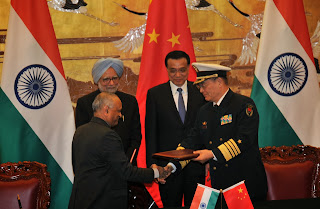 |
| Signing BDCA |
“China and India are willing to deepen our political mutual trust, practical cooperation, and also expand people-to-people and cultural exchanges. All of this requires a good media environment. I hope that the friends of the press will play your special role and magnify and spread afar the stories of China and India’s joint commitment to deepen cooperation, friendship and pursue development.”
Chinese Premier Li Keqiang at the Joint media statement session with Prime Minister Manmohan Singh in Beijing on 23October 2013.
That the Chinese Premier needed to specifically mention his expectation from the media in an official statement perhaps brings out clearly the apprehension that the Chinese have about what many Chinese leaders call “disruptive” influence of the Indian media on the Sino-India relations. Privately, Indian officials often cite a Chinese complaint which paints the media in India as the spoiler in the efforts to build better relations between New Delhi and Beijing. This is only half truth. Very often even Chinese media has belligerent and bellicose voices articulating warnings to India. It always takes two hands to clap, after all.
But the homily to media notwithstanding, Prime Minister Singh’s two-day trip to China was well highlighted both in Indian and Chinese media.
As The Hindu’s Ananth Krishnan reported from Beijing: “The outcome of Prime Minister Manmohan Singh’s two-day visit to China, especially the Border Defence Cooperation Agreement (BDCA), has underlined both countries’ willingness to manage their differences and sent “a positive and powerful message” to the world, said Chinese officials and state media on Friday.”
“There is a Chinese saying that a distant relative is not as good as a close neighbour,” said Foreign Ministry spokesperson Hua Chunying here. Beijing, she said, was “committed to building up strategic mutual trust” and “deepening practical cooperation across the board” with its neighbours.
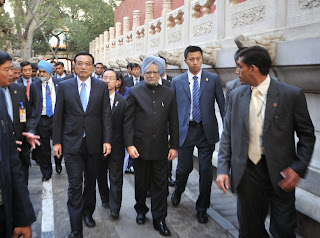 |
| In the Forbidden City |
The BDCA, which expands and formalises additional confidence-building measures, was described as a “landmark legal document” in an article published in the State-run China Daily. “Beijing and New Delhi have successfully brought the border situation under control and properly handled the latest ups and downs,” said Qu Xing, a senior strategic affairs scholar and head of the China Institute of International Studies, affiliated to the Foreign Ministry.
The agreement, he told the newspaper, will “help eliminate potential misunderstanding and misjudgement”.
On 23 October, India and China signed what is now being called a ‘landmark’ Border Defence Cooperation Agreement or BDCA in the presence of the two Prime Ministers.
Eight other pacts including one on sharing more data on trans-border rivers were also inked by the two sides but the centre piece undoubtedly was the border cooperation agreement which seeks to avoid an incident like the one along the Line of Actual Control (LAC) in April this year when Chinese troops marched 19 km inside Indian territory in Ladakh and camped there for three weeks before withdrawing.
That episode almost derailed the visit of the Chinese Premier–his first abroad–to India. It took at least half a dozen flag meetings and intervention at a much higher level to defuse the situation. The leadership in both countries therefore needed to put in place a new border management pact pending final settlement.
Given that background, Prime Minister Manmohan Singh was justifiably satisfied with the incremental progress that he managed to achieve during the two-day trip.
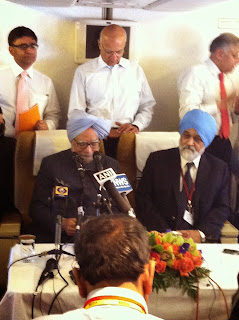 |
| On Board AI One |
Speaking to the accompanying media persons on board his special aircraft Air India One, after concluding the visit Dr. Singh said: “In China, my visit was to follow up on the process of getting to know the new Chinese leadership better. China is our largest neighbour, a significant economic partner and a country with increasing global presence. While we have our differences, there are many areas, bilateral, regional and multilateral, where cooperation among us is to our mutual benefit. It is only through a process of intense engagement that we will be able to move forward in all areas. I am satisfied that my just concluded visit has served its purpose.”
Not everyone will agree with the assertion but the centre piece of the Indian Prime Minister’s trip was undoubtedly the Border Defence Cooperation Agreement or BDCA which laid down more communication between tactical and strategic commanders and even at higher level between representatives of defence ministries of both the countries, hinted at a proposed ‘hotline’ between military headquarters and formalised an understanding on “no tailing” of troops when they come face to face on the long border.
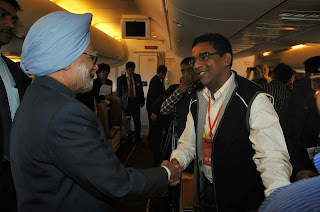 |
| On Board AI One |
A closer scrutiny of the agreement however reveals that it has only managed to add layers to the already existing mechanisms to maintain peace and tranquility on the border. Many of the provisions were already discussed and included in earlier agreements.
For instance, Article IV of the BDCA, 2013 states: “In implementing border defence cooperation and to facilitate contacts and meetings between relevant organizations, the two sides may establish Border Personnel Meeting sites in all sectors, as well as telephone contacts and telecommunication links at mutually agreed locations along the line of actual control. The two sides may also consider establishing a Hotline between the military headquarters of the two countries. Specific arrangements shall be decided upon through mutual consultations between the two sides.”
Now read this from the November 1996 agreement (Article VII):
In order to strengthen the cooperation between their military personnel and establishments in the border areas along the line of actual control, the two sides agree:
(1) To maintain and expand the regime of scheduled and flag meetings between their border representatives at designated places along the line of actual control;
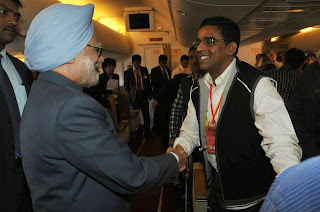 (2) To maintain and expand telecommunication links between their border meeting points at designated places along the line of actual control:
(2) To maintain and expand telecommunication links between their border meeting points at designated places along the line of actual control:(3) To establish step-by-step medium and high-level contacts between the border authorities of the two sides.
Indian officials acknowledged that the latest pact is a marginal improvement on the three earlier agreements but were at pains to explain that the BDCA would in no way impinge upon India’s belated efforts to build and improve infrastructure all along the Line of Actual Control. India is building 75 strategic roads, laying important railway lines and constructing operational assets in the difficult terrain on the China frontier to support the raising of a new Mountain Strike Corps and improving airfields for the Indian Air Force. None of these projects are likely to be completed earlier than 2018.
In that context, Indian Military officers, not wanting to be identified, admitted that the BDCA may have bought them more time without compromising on basic security requirements. They had in fact feared a more “binding” BDCA that would have further restricted their right to handle the situation on ground as they deemed fit. The ‘limit of patrolling’ imposed on the Indian Army troops deployed along the more sensitive areas of the LAC has also thankfully remained unchanged, they added. “At least now we know that the higher leadership will immediately come into play if another crisis like Depsang arises,” one of them remarked. So at best the agreement can be described as half a step forward.
The fine print of the BDCA notwithstanding Prime Minister Singh, perhaps on his last visit to China in the current tenure, was accorded special treatment by the Chinese leadership. President Xi Jingping and Premier Li Keqiang both hosted banquets for him. More markedly, former Premier Wen Jiabao who stepped down earlier this year hosted a lunch for his “old” friend Singh. This was a major change from established norms in China where retired leaders strictly keep off public appearances. Premier Li personally showed Dr. Singh around the historic Forbidden City. Dr. Singh also addressed the Central Party School, an honour rarely bestowed on visiting dignitary and outlined the future road map of Sino-India relationship.
 |
| At the party school |
Dr. Singh, mindful of the domestic concerns that New Delhi repeatedly succumbs to Chinese pressure on various fronts repeatedly stressed the need for a peaceful border and eventually an honourable settlement. He also flagged India’s concerns on continuing Chinese assistance to India’s South Asia rival Pakistan and unfavourable trade balance.
As the Indian Prime Minister said: “We agreed that peace and tranquility on our borders must remain the foundation for growth in the India-China relationship, even as we move forward the negotiations towards a fair, reasonable and mutually acceptable settlement to the India-China Boundary Question. This will be our strategic benchmark… as large neighbours following independent foreign policies, the relationships pursued by India and China with other countries must not become a source of concern for each other. This will be our strategic reassurance.”
While Beijing did not react on oblique Indian references to its “all-weather” friendship with Pakistan, it was clear China wants to keep up continuous engagement with India lest New Delhi forms a closer compact with the US, Japan and Australia. If India is wise enough it will continue to strike the right balance in its relationship with Beijing and not succumb to its charm offensive even as it pursues an independent foreign policy.




 (2) To maintain and expand telecommunication links between their border meeting points at designated places along the line of actual control:
(2) To maintain and expand telecommunication links between their border meeting points at designated places along the line of actual control:
